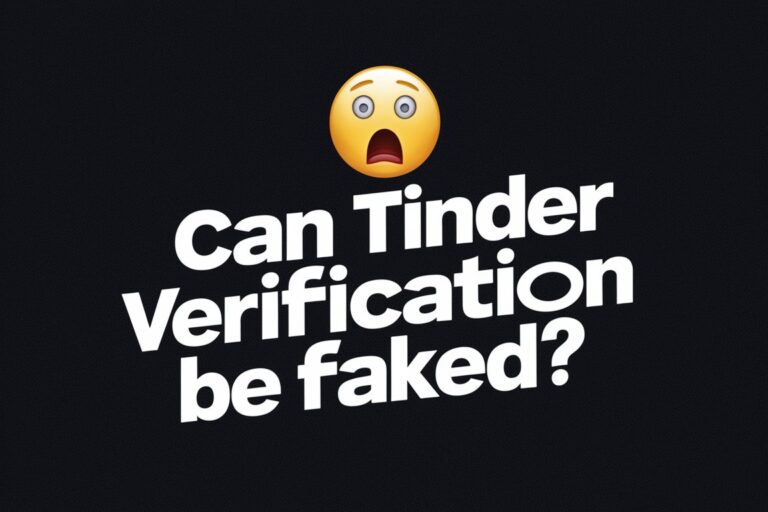Swiping on Tinder, you come across an intriguing profile. Gorgeous photos, witty bio, lots of common interests. “Could this be my dream match?” you wonder.
But in the era of catfishing and romance scams, you can’t help but be a little suspicious.
You notice the tiny blue checkmark next to their name. “Ah, they’re verified! This must be a real person!”
Or is it? So, let’s explore Can Tinder verification be faked?
How Does Tinder Verification Work?
Tinder’s verification system is designed to confirm users are who they claim to be. When requesting verification, you snap a selfie mimicking a specific pose shown on the screen. Tinder’s technology then compares this to your profile’s photos, checking that the images match up with the same person.
If everything looks good, your account gets a blue verification badge, so people know you’re legit. It seems pretty solid, but some persistent scammers have found workarounds.
The Fake Photo Trick

One way fakers bypass Tinder verification is by uploading a single real photo of themselves, just to get approved. After verification, they delete the real selfie and upload a bunch of fake model shots instead.
Even if people get suspicious later, that blue tick lends credibility, so victims tend to let their guard down. While their original verification selfie technically checked out, the rest of the profile is completely fabricated.
Outsourcing Verification
Other scammers have taken things a step further by outsourcing Tinder verification. They hire people to take real-life selfies for them, mimicking the app’s pose requirements.
The resulting photos get uploaded to fake accounts, passing the system’s checks with flying colors. Now completely bogus profiles can get that coveted verified stamp without the person behind them being real at all.
Red Flags To Watch For
While clever social engineers have found ways around it, Tinder verification still makes catfishing harder. Here are some red flags to watch out for:
- Only one photo on a profile
- Images look overly professional/edited
- Bio info seems too perfect
- Witty banter turns to requests for cash or personal data
If anything raises your suspicions, reverse image search their photos. See if they appear elsewhere online tied to different names. And don’t ignore your gut feeling – if a profile seems fake despite verification, it very well might be.
Why So Many Fakes?

With so much effort invested into scamming, you have to wonder…why bother with Tinder? What’s the end goal here?
Unfortunately, there’s decent cash to be made tricking lovestruck singles. While motivations vary, typical catfish tend to scam in a few ways:
Romance fraud
Sweet-talk naive hopeless romantics into online relationships before asking for large sums of money – purchases, investments, medical emergencies, etc.
Sextortion
Coaxing risque selfies and texts from victims and threatening to share them publicly if blackmail payments aren’t made.
Affiliate marketing
Directing matches to purchase products using their affiliate links – luring victims in with deals before taking commissions.
Spreading malware
Encouraging matches to click on embedded links that download viruses and hacking tools onto user devices.
Of course, most people on Tinder are genuinely looking for love. But being aware of potential dangers is key to staying safe as you try to spot your soulmate in the crowd!
How To Tell If A Profile Is Fake
Beyond verification badges, how do you spot fakes lurking on Tinder?
Here are some tips:
- Analyze account activity. Imposters often have fresh accounts with minimal posts and friends. This minimizes evidence tying them to alternate identities.
- Look for stolen photos. Catfish nab provocative profile shots from random Instagram models then pretend to be them online. But reverse image searches reveal the original sources.
- Watch for texting red flags. Scammers push conversations off Tinder immediately to minimize accountability. They also avoid custom selfies featuring unique poses or hand signals that you request to “prove” their identity.
- Observe changes over time. After reeling victims in emotionally, catfish often replace original profile photos with glamorous (stolen) model shots.
Staying attentive helps visitors determine who’s the real deal. But when in doubt, go with your gut!
Protecting Yourself On Tinder

Beyond verifying matches, here are some general tips to avoid being manipulated while swiping:
- Guard personal information. Never hand out banking details, access codes, specific addresses, or other sensitive intel. Sophisticated attackers can exploit these or trick safety question resets.
- Meet first dates in public. When ready to take things offline, pick a safe busy location like a café so you can bail if uncomfortable. Drive yourself or organize your own transport there and back too.
- Inform friends/family about plans. Tell circled ones where you’re going, who you’re meeting, and when you expect to check in so they can follow up if concerned.
- Watch drinks & belongings. Never leave food or beverages unattended around unfamiliar matches. A turned head lets crafty beings slip in substances.
- Trust your intuition. If a profile seems fake despite verification, listen to your gut. You’re better safe than sorry when identities seem suspicious. Unmatch, block or report them to Tinder if uncertain.
Can Tinder Verification Be Bypassed?
Like any system, Tinder’s checks are not foolproof. Committed scammers invest heavy effort into appearing credible, faking verification being one approach.
But while worrying, remember most Tinderites are authentic people genuinely searching for love. By avoiding isolation, protecting personal data, meeting safely, and acting on intuitions, you can enjoy the experience while minimizing risks.
The whole point of verifying profiles is allowing visitors to feel more confident in matches. But there will always be a minority of sophisticated tricksters trying to exploit naiveté. With awareness and prudent precautions, however, their tactics need not ruin digital dating adventures for the rest of us!
Stay wise and best of luck finding love!

